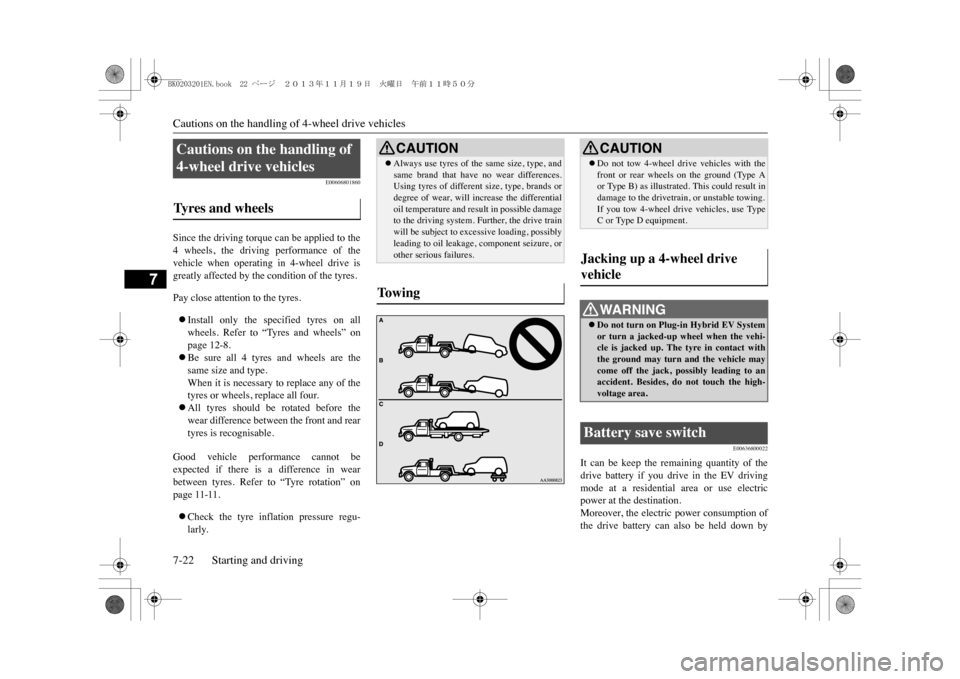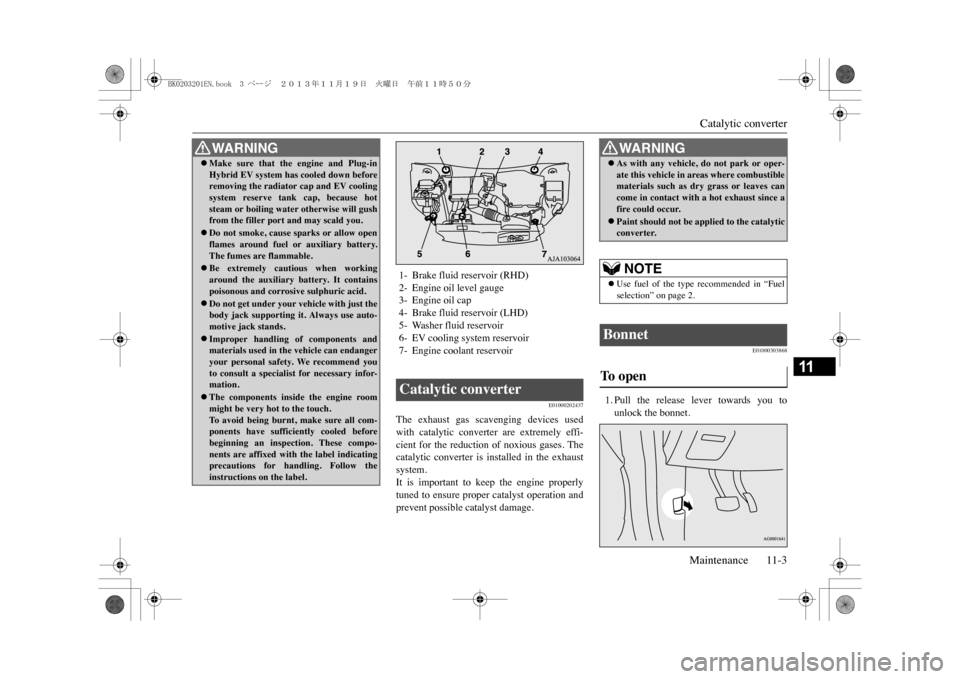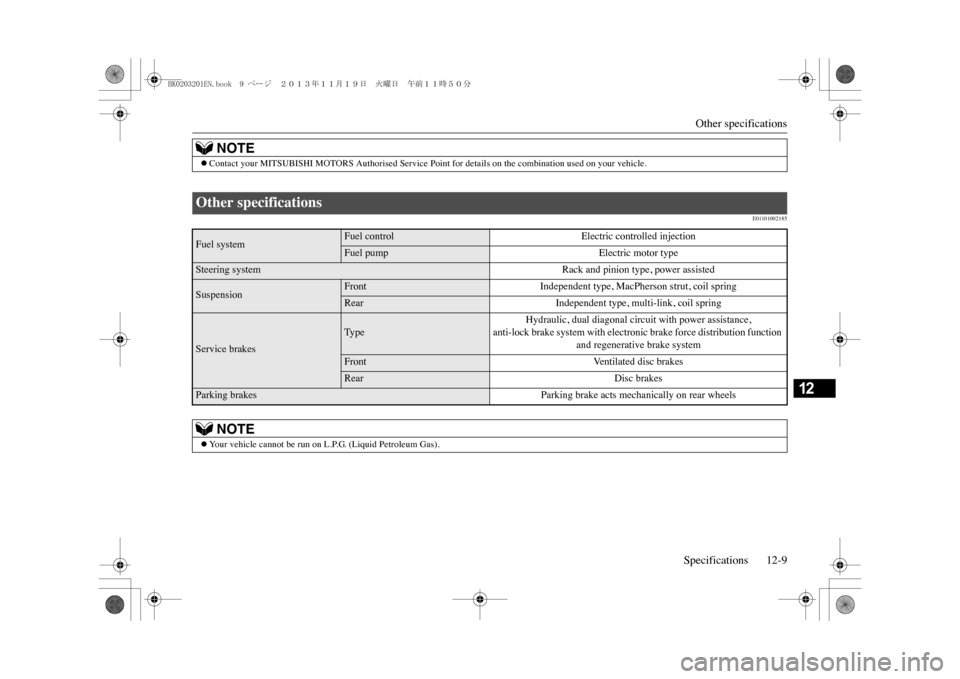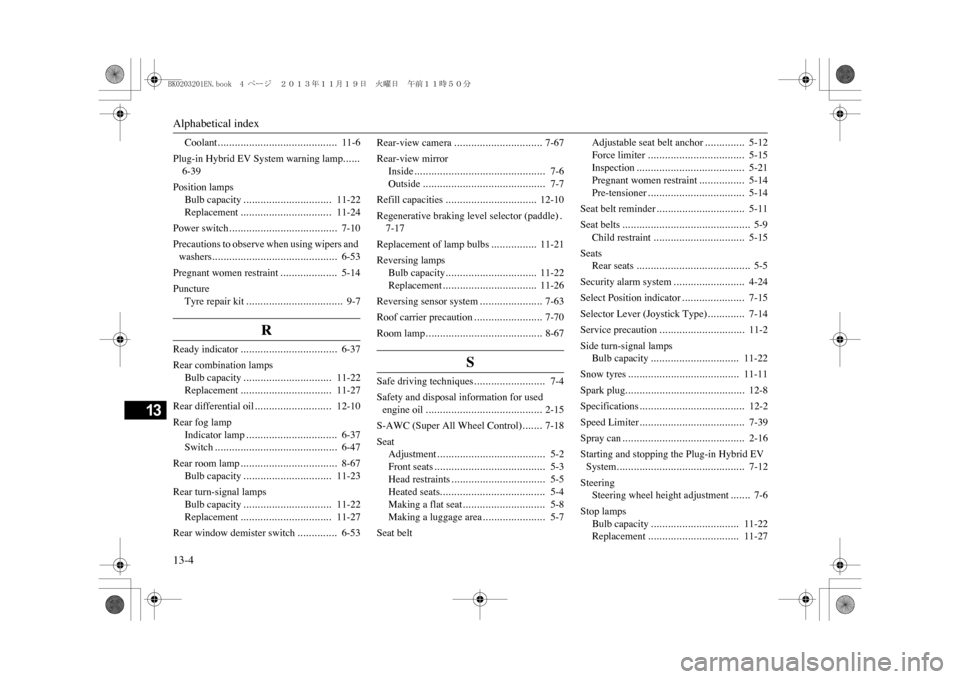2014 MITSUBISHI OUTLANDER SPORT oil type
[x] Cancel search: oil typePage 185 of 388

Cautions on the handling of 4-wheel drive vehicles7-22 Starting and driving
7
E00606801860
Since the driving torque can be applied to the4 wheels, the driving performance of thevehicle when operating in 4-wheel drive isgreatly affected by the condition of the tyres.Pay close attention to the tyres.�zInstall only the specified tyres on allwheels. Refer to “Tyres and wheels” onpage 12-8.�zBe sure all 4 tyres and wheels are thesame size and type.When it is necessary to replace any of thetyres or wheels, replace all four.�zAll tyres should be rotated before thewear difference between the front and reartyres is recognisable.
Good vehicle performance cannot beexpected if there is a difference in wearbetween tyres. Refer to “Tyre rotation” onpage 11-11.�zCheck the tyre inflation pressure regu-larly.
E00636800022
It can be keep the remaining quantity of thedrive battery if you drive in the EV drivingmode at a residential area or use electricpower at the destination.Moreover, the electric power consumption ofthe drive battery can also be held down by
Cautions on the handling of 4-wheel drive vehicles Ty r e s a n d w h e e l s
CAUTION�zAlways use tyres of the same size, type, andsame brand that have no wear differences.Using tyres of different size, type, brands ordegree of wear, will increase the differentialoil temperature and result in possible damageto the driving system. Further, the drive trainwill be subject to exce
ssive loading, possibly
leading to oil leakage, component seizure, orother serious failures.
To w i n g
CAUTION�zDo not tow 4-wheel driv
e vehicles with the
front or rear wheels on the ground (Type Aor Type B) as illustrated. This could result indamage to the drivetrain, or unstable towing.If you tow 4-wheel drive vehicles, use TypeC or Type D equipment.
Jacking up a 4-wheel drive vehicle
WA R N I N G�zDo not turn on Plug-in Hybrid EV Systemor turn a jacked-up wheel when the vehi-cle is jacked up. The tyre in contact withthe ground may turn and the vehicle maycome off the jack, possibly leading to anaccident. Besides, do not touch the high-voltage area.
Battery save switch
BK0203201EN.book 22 ページ 2013年11月19日 火曜日 午前11時50分
Page 328 of 388
![MITSUBISHI OUTLANDER SPORT 2014 3.G Owners Manual How to change a tyre
For emergencies 9-17
9
7. Turn the wheel nuts clockwise by hand toinitially tighten them.[Type 1: On vehicles with steel wheels]Te m p o r a r i l y t i g h t e n t h e w h MITSUBISHI OUTLANDER SPORT 2014 3.G Owners Manual How to change a tyre
For emergencies 9-17
9
7. Turn the wheel nuts clockwise by hand toinitially tighten them.[Type 1: On vehicles with steel wheels]Te m p o r a r i l y t i g h t e n t h e w h](/manual-img/19/7545/w960_7545-327.png)
How to change a tyre
For emergencies 9-17
9
7. Turn the wheel nuts clockwise by hand toinitially tighten them.[Type 1: On vehicles with steel wheels]Te m p o r a r i l y t i g h t e n t h e w h e e l n u t s b yhand until the tapered parts of the wheelnuts make light contact with the seats ofthe wheel holes and the wheel is notloose.[Type 2: On vehicles with aluminiumwheels]Te m p o r a r i l y t i g h t e n t h e w h e e l n u t s b yhand until the flange parts of the wheelnuts make light contact with the wheeland the wheel is not loose.
8. Lower the vehicle slowly by rotating thewheel nut wrench anticlockwise until thetyre touches the ground.
9. Tighten the nuts in the order shown in theillustration until each nut has been tight-ened to the torque listed here.Tightening torque 88 to 108 N•m
10. On vehicles with wheel covers, install the
covers (refer to “Wheel covers” on page9-18).
11. Lower and remove the jack, then store the
jack, flat tyre, and chocks. Have yourdamaged tyre repaired as soon as possi-ble.
CAUTION�zNever apply oil to either the wheel bolts orthe nuts or they will tighten too much.
Ty p e 1Ty p e 2
NOTE
�zOn vehicles with aluminium wheels, if all 4aluminium wheels are changed to steelwheels. e. g. when fitting winter tyres, usetapered nuts.
CAUTION�zNever use your foot or
a pipe extension for
extra force in the wheel nut wrench. If youdo so, you will tighten the nut too much.
BK0203201EN.book 17 ページ 2013年11月19日 火曜日 午前11時50分
Page 330 of 388

Towing
For emergencies 9-19
9
2. Align the air valve (C) of the tyre with thenotch (D) in the wheel cover.3. Push the underside (F) of the wheel coverinto the wheel.4. Gently push both sides (G) of the wheelcover and hold it in place with both knees.
5. Gently tap around the circumference ofthe wheel cover at the top (H), then pressthe wheel cover into place.
E00801504940
If you need to tow your vehicle, contact aMITSUBISHI MOTORS Authorised ServicePoint or a commercial tow truck service.Transport the vehicle on a flatbed truck ortow the vehicle with all wheels off theground.
In the following cases, contact a MITSUBI-SHI MOTORS Authorised Service Point andtransport the vehicle with the all wheels on acarriage.�zThe ready indicator illuminates but thevehicle does not move, or an abnormalnoise is produced.�zSome warning lamp in the meter illumi-nates.�zInspection of the vehicle’s undersidereveals that oil or some other fluid is leak-ing.�zYo u r v e h i c l e b o d y i s s e v e r e l y d a m a g e d o rdeformed in the event of an accident.
If a wheel gets stuck in a ditch, do not try totow the vehicle.
NOTE
�zFull wheel covers have a symbol mark (E)provided on the reverse side to show the airvalve location.Before installing the wheel cover to thewheel, make sure that the opening with thesymbol mark is correctly aligned with the airvalve.
To w i n g If your vehicle needs to be towed
Flat bed typeDolly type
BK0203201EN.book 19 ページ 2013年11月19日 火曜日 午前11時50分
Page 344 of 388

Catalytic converterMaintenance 11-3
11
E01000202437
The exhaust gas scavenging devices usedwith catalytic converter are extremely effi-cient for the reduction of noxious gases. Thecatalytic converter is installed in the exhaustsystem.It is important to keep the engine properlytuned to ensure proper catalyst operation andprevent possible catalyst damage.
E01000303868
1. Pull the release lever towards you tounlock the bonnet.
�zMake sure that the engine and Plug-inHybrid EV system has cooled down beforeremoving the radiator cap and EV coolingsystem reserve tank cap, because hotsteam or boiling water otherwise will gushfrom the filler port and may scald you.�zDo not smoke, cause sparks or allow openflames around fuel or auxiliary battery.The fumes are flammable.�zBe extremely cautious when workingaround the auxiliary battery. It containspoisonous and corrosive sulphuric acid.�zDo not get under your vehicle with just thebody jack supporting it. Always use auto-motive jack stands.�zImproper handling of
components and
materials used in the vehicle can endangeryour personal safety. We recommend youto consult a specialist for necessary infor-mation.�zThe components inside the engine roommight be very hot to the touch.To a v o i d b e i n g b u r n t , m a k e s u r e a l l c o m -ponents have sufficiently cooled beforebeginning an inspection. These compo-nents are affixed with the label indicatingprecautions for handling. Follow theinstructions on the label.WA R N I N G
1- Brake fluid reservoir (RHD)2- Engine oil level gauge3- Engine oil cap4- Brake fluid reservoir (LHD)5- Washer fluid reservoir6- EV cooling system reservoir7- Engine coolant reservoirCatalytic converter
WA R N I N G�zAs with any vehicle, do not park or oper-ate this vehicle in areas where combustiblematerials such as dry grass or leaves cancome in contact with a hot exhaust since afire could occur.�zPaint should not be applied to the catalyticconverter.NOTE
�zUse fuel of the type recommended in “Fuelselection” on page 2.
Bonnet To o p e n
BK0203201EN.book 3 ページ 2013年11月19日 火曜日 午前11時50分
Page 346 of 388

Engine oil
Maintenance 11-5
11
E01000404039
The engine oil used has a significant effect onthe engine’s performance, service life andstartability. Be sure to use oil of the recom-mended quality and appropriate viscosity.All engines consume a certain amount of oilduring normal operation. Therefore, it isimportant to check the oil level at regularintervals or before starting a long trip.1. Park the car on a horizontal surface.2. Switch off the engine.3. Wait a few minutes.4. Remove the dipstick and wipe it with aclean cloth.5. Reinsert the dipstick as far as it goes.
6. Remove the dipstick and read the oillevel, which should always be within therange indicated7. If the oil level is below the specified limit,remove the cap located on the cylinderhead cover and add enough oil to raise thelevel to within the specified range. Do notoverfill to avoid engine damage. Be sureto use the specified engine oil and do notmix various types of oil.8. After adding oil, close the cap securely.9. Confirm the oil level by repeating step 4to 6.
�zSelect engine oil of the proper SAE vis-cosity number according to the atmos-pheric temperature.SAE 0W-20, 0W-30, 5W-30, and 5W-40engine oils can only be used if they meetACEA A3/B3, A3/B4 or A5/B5 and APISG (or higher) specifications.�zUse engine oil conforming to the follow-ing classification:•API classification: “For service SG” orhigher•ILSAC certificated oil•ACEA classification:“For service A1/B1, A3/B3, A3/B4, orA5/B5”
Engine oil To c h e c k a n d r e f i l l e n g i n e o i l
FULL LOW
NOTE
�zThe engine oil will dete
riorate rapidly if the
vehicle is subjected to severe conditions,requiring earlier oil replacement.Please refer to the maintenance schedule.�zFor information on how to dispose of usedengine oil, refer to page 2-15.
Recommended engine oil vis-cosity
BK0203201EN.book 5 ページ 2013年11月19日 火曜日 午前11時50分
Page 351 of 388

Tyres11-10 Maintenance
11
E01001402726
*: Above 160 km/hCheck the tyre inflation pressure of all the tyres while they ar
e cold; if insufficient or excessive, adjust to the specified v
alue.
After the tyre inflation pressure has been adjusted, check the tyres for damage and air leaks. Be sure to put caps on the valve
s.
E01001801970
Check the tyres for cuts, cracks and otherdamage. Replace the tyres if there are deep
cuts or cracks. Also check each tyre forpieces of metal or pebbles.The use of worn tyres can be very dangerousbecause of the greater chance of skidding orhydroplaning. The tread depth of the tyresmust exceed 1.6 mm in order for the tyres tomeet the minimum requirement for use.Tread wear indicators will appear on the sur-face of the tyre as the tyre wears, therebyindicating that the tyre no longer meets theminimum requirement for use. When thesewear indicators appear, the tyres must bereplaced with new ones.When replacement of any of the tyres is nec-essary, replace all of them.
Ty r e i n f l a t i o n p r e s s u r e s
Ty re s i z e
Front
Rear
215/70R16 100H
2.4 bar (35 PSI) [240 kPa], 2.6 bar (38 PSI) [260 kPa]
*
225/55R18 98H
2.4 bar (35 PSI) [240 kPa]], 2.6 bar (38 PSI) [260 kPa]
*
Wheel condition 1- Location of the tread wear indicator2- Tread wear indicator
CAUTION�zAlways use tyres of the same size, sametype, and same brand, and which have nowear differences. Using tyres of differentsize, type, brands or
degree of wear, will
increase the differential oil temperature,resulting in possible damage to the drivingsystem. Further, the drive train will be sub-jected to excessive loading, possibly leadingto oil leakage, component seizure, or otherserious faults.
BK0203201EN.book 10 ページ 2013年11月19日 火曜日 午前11時50分
Page 378 of 388

Other specifications
Specifications 12-9
12
E01101002185
NOTE
�zContact your MITSUBISHI MOTORS Aut
horised Service Point for details on
the combination used on your vehicle.
Other specifications Fuel system
Fuel control
Electric controlled injection
Fuel pump
Electric motor type
Steering system
Rack and pinion type, power assisted
Suspension
Front
Independent type, MacPherson strut, coil spring
Rear
Independent type, multi-link, coil spring
Service brakes
Ty p e
Hydraulic, dual diagonal circuit with power assistance,
anti-lock brake system with electronic brake force distribution function
and regenerative brake system
Front
Ve n t i l a t e d d i s c b r a k e s
Rear
Disc brakes
Parking brakes
Parking brake acts mechanically on rear wheels
NOTE
�zYo u r v e h i c l e c a n n o t b e r u n o n L .
P. G. ( L i q u i d P e t r o l e u m G a s ) .
BK0203201EN.book 9 ページ 2013年11月19日 火曜日 午前11時50分
Page 385 of 388

Alphabetical index13-4
13
Coolant
..........................................
11-6
Plug-in Hybrid EV System warning lamp
......
6-39Position lamps
Bulb capacity
...............................
11-22
Replacement
................................
11-24
Power switch
......................................
7-10
Precautions to observe when using wipers and washers
............................................
6-53
Pregnant women restraint
....................
5-14
Puncture
Tyre repair kit
..................................
9-7
R
Ready indicator
..................................
6-37
Rear combination lamps
Bulb capacity
...............................
11-22
Replacement
................................
11-27
Rear differential oil
...........................
12-10
Rear fog lamp
Indicator lamp
................................
6-37
Switch
...........................................
6-47
Rear room lamp
..................................
8-67
Bulb capacity
...............................
11-23
Rear turn-signal lamps
Bulb capacity
...............................
11-22
Replacement
................................
11-27
Rear window demister switch
..............
6-53
Rear-view camera
...............................
7-67
Rear-view mirror
Inside
..............................................
7-6
Outside
...........................................
7-7
Refill capacities
................................
12-10
Regenerative braking level selector (paddle)
.
7-17Replacement of lamp bulbs
................
11-21
Reversing lamps
Bulb capacity
................................
11-22
Replacement
.................................
11-26
Reversing sensor system
......................
7-63
Roof carrier precaution
........................
7-70
Room lamp
.........................................
8-67
S
Safe driving techniques
.........................
7-4
Safety and disposal information for used engine oil
.........................................
2-15
S-AWC (Super All Wheel Control)
.......
7-18
Seat
Adjustment
......................................
5-2
Front seats
.......................................
5-3
Head restraints
.................................
5-5
Heated seats
.....................................
5-4
Making a flat seat
.............................
5-8
Making a luggage area
......................
5-7
Seat belt
Adjustable seat belt anchor
..............
5-12
Force limiter
..................................
5-15
Inspection
......................................
5-21
Pregnant women restraint
................
5-14
Pre-tensioner
..................................
5-14
Seat belt reminder
...............................
5-11
Seat belts
.............................................
5-9
Child restraint
................................
5-15
Seats
Rear seats
........................................
5-5
Security alarm system
.........................
4-24
Select Position indicator
......................
7-15
Selector Lever (Joystick Type)
.............
7-14
Service precaution
..............................
11-2
Side turn-signal lamps
Bulb capacity
...............................
11-22
Snow tyres
.......................................
11-11
Spark plug
..........................................
12-8
Specifications
.....................................
12-2
Speed Limiter
.....................................
7-39
Spray can
...........................................
2-16
Starting and stopping the Plug-in Hybrid EV System
.............................................
7-12
Steering
Steering wheel height adjustment
.......
7-6
Stop lamps
Bulb capacity
...............................
11-22
Replacement
................................
11-27
BK0203201EN.book 4 ページ 2013年11月19日 火曜日 午前11時50分